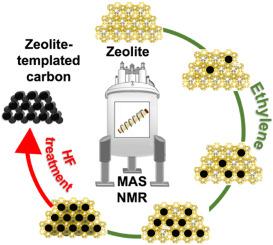沸石模板碳的形成和支架相互作用——来自固态核磁共振波谱的见解
IF 4.7
3区 材料科学
Q1 CHEMISTRY, APPLIED
引用次数: 0
摘要
沸石模板碳(ztc)结合了无与伦比的结构特性和高导电性,使其成为能源应用的有希望的候选者,例如电池和燃料电池的电极或催化剂载体。然而,对于沸石中碳相的形成机制、与模板沸石的分子相互作用以及最终碳材料在分子水平上的结构,我们所知甚少。本文采用固体核磁共振波谱技术系统地研究了两种具有FAU和EMT拓扑结构的沸石合成的富13c ztc的形成机理。通过合成时间的变化,我们观察到碳形成的中间阶段,表明单个沸石空隙最初由较小的碳种填充,逐渐长成较大的结构。沸石宿主的质子与新生碳质相之间的直接相互作用不能被证明。然而,对沸石支架的进一步研究表明,沸石的短程结构在碳形成过程中受到影响,由客体相引起的键角和长度扭曲。本文章由计算机程序翻译,如有差异,请以英文原文为准。

Formation and scaffold interaction of zeolite-templated carbons – Insight from solid-state nuclear magnetic resonance spectroscopy
Zeolite-templated carbons (ZTCs) combine unparalleled textural properties and high electric conductivity, making them promising candidates in energy applications, such as electrodes in batteries and in fuel cells or as catalyst supports. However, rather little is known about the formation mechanism of the carbon phase within the zeolite, its molecular interactions with the template zeolite and about the structure of the final carbon materials on a molecular level. Herein, we systematically examine the formation mechanism of 13C-enriched ZTCs synthesized using two zeolites with FAU and EMT topologies by solid-state NMR spectroscopy. By variation of the synthesis time we observe intermediate stages of the carbon formation, suggesting that individual zeolite voids are initially filled with smaller carbon species that progressively grow into larger structures. Direct interaction between the protons of the zeolitic host and the nascent carbonaceous phase could not be evidenced. However, a closer examination of the zeolitic scaffolds revealed that the short-range structure of the zeolite is impacted during carbon formation, with distortions in bond angles and lengths induced by the guest phase.
求助全文
通过发布文献求助,成功后即可免费获取论文全文。
去求助
来源期刊

Microporous and Mesoporous Materials
化学-材料科学:综合
CiteScore
10.70
自引率
5.80%
发文量
649
审稿时长
26 days
期刊介绍:
Microporous and Mesoporous Materials covers novel and significant aspects of porous solids classified as either microporous (pore size up to 2 nm) or mesoporous (pore size 2 to 50 nm). The porosity should have a specific impact on the material properties or application. Typical examples are zeolites and zeolite-like materials, pillared materials, clathrasils and clathrates, carbon molecular sieves, ordered mesoporous materials, organic/inorganic porous hybrid materials, or porous metal oxides. Both natural and synthetic porous materials are within the scope of the journal.
Topics which are particularly of interest include:
All aspects of natural microporous and mesoporous solids
The synthesis of crystalline or amorphous porous materials
The physico-chemical characterization of microporous and mesoporous solids, especially spectroscopic and microscopic
The modification of microporous and mesoporous solids, for example by ion exchange or solid-state reactions
All topics related to diffusion of mobile species in the pores of microporous and mesoporous materials
Adsorption (and other separation techniques) using microporous or mesoporous adsorbents
Catalysis by microporous and mesoporous materials
Host/guest interactions
Theoretical chemistry and modelling of host/guest interactions
All topics related to the application of microporous and mesoporous materials in industrial catalysis, separation technology, environmental protection, electrochemistry, membranes, sensors, optical devices, etc.
 求助内容:
求助内容: 应助结果提醒方式:
应助结果提醒方式:


